Inspiring Backyard Ideas for a Pool-Free Space
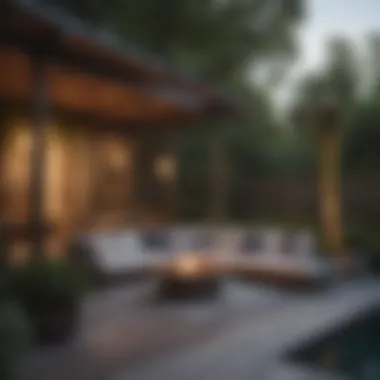

Intro
Backyards serve as extensions of our homes. They offer us a space for creativity, relaxation, and gathering. However, not every backyard needs a pool to be inviting or functional. This article aims to showcase creative ideas that enrich the experience of outdoor living without relying on a pool. From landscaping techniques to unique setups, there are various avenues to explore in enhancing your outdoor space.
The absence of a pool provides room for alternative designs and activities, all aimed at enriching homeowner's outdoor living experiences. In this discussion, we will dive into landscaping inspirations, furniture selection, and gardening practices. Each element contributes to crafting spaces that are not only aesthetically pleasing but also sustainable and low-maintenance.
Design Inspiration
Transforming a backyard without a pool requires a keen eye for design. Focusing on key trends and color palettes can provide a fresh outlook on outdoor spaces.
Current Trends in Outdoor Design
Current design trends emphasize minimalism and nature integration. Homeowners lean toward simpler styles that promote tranquility. Natural materials such as wood and stone are popular choices for paths, decks, and furniture.
Maintaining a connection with nature is essential. Features like stone fire pits or wooden pergolas allow one to enjoy the outdoors without overwhelming the space. Additionally, multifunctional furniture that blends style and practicality is key. Look for chairs that offer storage or tables that can adapt to different needs.
Color Schemes and Palette Ideas
Color plays a significant role in outdoor design. Earthy tones, like deep greens, browns, and grays, can create a harmonious aesthetic that resonates with nature. Bright accents, such as vibrant cushions or vivid planters, can liven up the surroundings without overpowering.
Suggested Color Palettes:
- Earth Tones: Olive green, taupe, rust.
- Soft Pastels: Light blue, blush, mint green.
- Bold Accents: Coral, teal, mustard yellow.
Gardening Techniques
Gardening enhances the beauty of any backyard. By choosing the right plants, one can create an inviting space, while also providing scalability for future additions.
Plant Selection and Care
Selecting plants that thrive in your climate reduces maintenance and increases enjoyment. Factors such as sun exposure, soil type, and water availability dictate plant choices. Consider native plants, as they often require less water and are more resilient.
Regular maintenance, such as pruning and watering, is crucial. Group plants according to their needs to simplify care. Indoor plants can complement outdoor gardens, creating a seamless transition from indoors to outdoors.
Indoor vs. Outdoor Gardening
Gardening can happen inside or out. Outdoor gardens allow for a wide variety of plants, including perennials and annuals that bloom throughout the seasons. Indoor gardening, however, promotes air quality and adds greenery to indoor spaces.
Integrating both forms allows for creativity. For instance, growing herbs outdoors and bringing them inside for cooking can enhance culinary experiences.
Finale
Creating a welcoming backyard without a pool involves thoughtful design and execution. By focusing on landscaping, furniture, and gardening, homeowners can fabricate a space that is both functional and beautiful. With a bit of planning and consideration for current trends and techniques, any outdoor area can become a sanctuary worth enjoying.
Prelims to Backyard Inspiration
Creating an inviting backyard space extends beyond mere aesthetics; it reflects a homeowner's personality and lifestyle. Many individuals consider swimming pools as a focal point, but there are abundant alternatives that can enhance both utility and visual appeal. Thinking creatively about the backyard invites more diverse features, making the area not just a yard, but an extension of the home itself. Such inspiration fosters a space that supports relaxation, entertainment, and even gardening, leading to a more satisfying outdoor experience.
Rethinking Pool Alternatives
In the quest for innovative backyard designs, homeowners can explore several alternatives to pools. Consider waterless scenarios such as large, elegantly designed patios equipped with comfortable furniture. Such areas promote outdoor leisure much like a pool would but with less maintenance. Incorporating features like outdoor kitchens and dining spaces not only provides functionality but also elevates social interactions among friends and family.
Additionally, installing features like fire pits can create a captivating gathering point. This element generates warmth and ambiance during cooler months, extending outdoor living's usability beyond the summer season. Essentially, by rethinking conventional ideas of relaxation, homeowners can create spaces that serve the same purpose as pools without incurring the associated costs and upkeep.
Understanding Your Space
Before implementing any design, it's crucial to understand the space available. Each backyard presents unique characteristics, whether it be size, shape, or existing features such as trees and structures. Begin by mapping out your yard's dimensions and noting any fixed elements.
Assess these factors:
- Sunlight Exposure: Identify which areas receive direct sunlight or remain shaded throughout the day. This understanding influences plant selection and placement for both comfort and aesthetics.
- Grade and Drainage: Evaluate the terrain. Slopes and dips can affect water flow. Proper drainage solutions may need to be integrated to prevent flooding or pooling water.
- Usage Patterns: Observe how you currently use the space. Consider gathering spots, pathways, and if children or pets will frequently use the area. Understanding these patterns will aid in creating a functional layout.
With clear insights into the backyard's specifics, homeowners will be equipped to make informed decisions, ultimately leading to a more cohesive and practical outdoor environment.
Establishing a Functional Layout
Establishing a functional layout in the backyard is central to achieving a harmonious outdoor space. When homeowners consider their backyard, they often envision an area that serves multiple purposes—be it an entertainment zone, a tranquil retreat, or a place for children to play. A well-planned layout enhances usability while reflecting an individual's style and preferences. This phase serves as the groundwork for all subsequent designs and ensures that every element has a designated purpose, avoiding any cluttered or chaotic impressions.
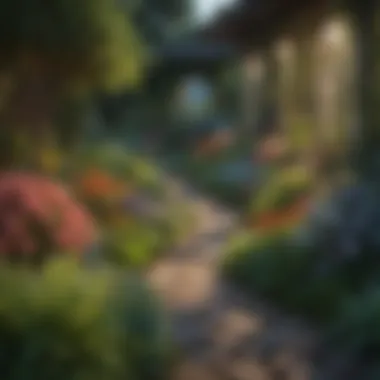
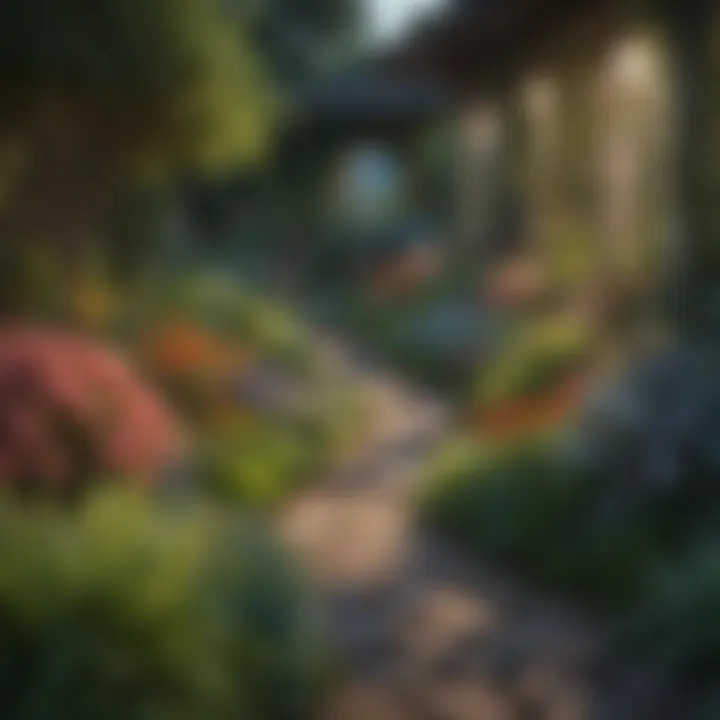
One key aspect of establishing this layout is the consideration of how different areas interact with each other. Homeowners should think about pathways, the placement of furniture, and how one section might complement another. This planning phase goes beyond aesthetics to encompass functionality. Additionally, it ensures that the backyard maintains a clear flow, allowing easy navigation from one space to another.
House and garden owners also need to consider aspects like sunlight exposure and wind patterns throughout the year. This awareness allows for the strategic placement of shaded areas, making outdoor spaces comfortable even during warmer months.
Zoning the Backyard
Zoning the backyard is a fundamental part of creating distinct areas tailored to specific activities. This method can elegantly separate sections for gardening, relaxation, and entertainment, preventing a disjointed look. Homeowners can establish zones using various techniques, such as plantings, hardscaping, or even furniture arrangements. For instance, a fire pit with seating can create a cozy gathering space, while taller plants can serve as a visual barrier, marking off a tranquil reading nook.
Considerations for zoning should also include elevation changes in the land, which can enhance privacy. Using levels can create interesting separation without the need for fences or walls, increasing both usability and aesthetic appeal.
Key zoning strategies include:
- Utilizing shrubs to delineate spaces.
- Laying out different materials in various zones, like stone or gravel paths for one area and grass for another.
- Positioning furniture distinctively, so gathering spaces feel intimate yet accessible.
Creating Pathways
Creating pathways is a practical and aesthetic method for enhancing the functionality of a backyard layout. Pathways guide movement through areas, making it clear where one can walk, sit, or stand. They add order and can define spaces while contributing to the overall design with different materials like bricks, mulch, or stone.
A well-designed pathway can offer visual interest while ensuring that every part of the backyard is easily accessible. Furthermore, pathways can serve practical purposes, such as preventing grass wear in high-traffic areas. They also help in connecting important feature areas like seating zones, gardens, and play areas.
When planning pathways, consider the following:
- The width of the pathway should accommodate foot traffic, generally about 36 inches.
- A winding path can enhance the backyard’s visual appeal, as opposed to straight lines, which can seem rigid.
- Using different materials for pathways can indicate transitions between zones, assisting in zoning while providing a pleasing visual experience.
In summary, creating a functional layout through zoning and pathways lays the foundation for a beautiful backyard. It is essential to balance aesthetics and practicality, ensuring all spaces are useful and inviting.
Landscaping Options
Landscaping is a fundamental aspect of backyard design. It significantly impacts the aesthetic and functional quality of the space. Careful planning of landscaping options enhances the look and feel of an outdoor area while considering maintenance and ecology. Choosing appropriate designs and plants can harmonize the space with nature, making it more enjoyable for both relaxation and social gatherings.
Using Native Plants
Using native plants in your backyard is a smart strategy. These plants adapt well to the local climate and soil conditions. They require less water and care once established. For instance, native wildflowers, grasses, and shrubs promote local wildlife such as bees and butterflies. This approach leads to a low-maintenance garden that thrives naturally, reducing the need for fertilizers or pesticides.
Choosing plants native to your region creates a more resilient ecosystem. They often offer seasonal beauty with colors and textures that match your local environment. Additionally, native plants can be a conversation starter, as they reflect a commitment to sustainable practices.
Incorporating Hardscaping Elements
Hardscaping plays a vital role in backyard landscaping. It includes non-plant elements such as patios, walkways, walls, and decks. These features provide structure and functionality. A well-designed hardscape can create defined areas for various uses, such as dining, relaxation, or gardening.
Materials like stone, wood, or concrete offer durability and can enhance visual interest. For example, a stone pathway leading to a fire pit creates a focal point that draws people into the yard. Meanwhile, retaining walls can be used to manage slopes and create terraced gardens. Moreover, hardscaping allows homeowners to express their personal style.
Vertical Gardening as an Aesthetic Choice
Vertical gardening is a creative way to maximize space. This technique involves growing plants on walls or trellises. It is ideal for smaller backyards where ground space is limited. Vertical gardens not only add greenery but also serve as unique art pieces.
Using pots or planters that attach to walls can create stunning displays of flowers or herbs. Vertical gardens also improve air quality and provide insulation. By choosing climbing plants like ivy or flowering vines, you can transform bare walls into lush landscapes. Beyond aesthetics, vertical gardening enhances privacy by creating visual barriers.
"Landscaping integrates nature seamlessly into living spaces, enhancing both beauty and functionality."
By exploring these landscaping options, homeowners can cultivate backyards that are both inviting and environmentally friendly. Each method contributes to a cohesive design, providing comfort and enjoyment without the need for a pool.
Functional Furniture Solutions
When considering the design and functionality of a backyard, functional furniture solutions play a significant role. They can transform outdoor spaces into comfortable and practical areas for relaxation, dining, and social gathering. These choices influence how the backyard is utilized throughout the year, catering to various activities, from casual get-togethers to family barbecues.
Choosing Durable Materials
Selecting the right materials for outdoor furniture is crucial for longevity and ease of maintenance. Weather-resistant materials like teak, eucalyptus, and powder-coated aluminum present ideal choices because they withstand varying climates without deteriorating. Additionally, synthetic materials such as high-density polyethylene (HDPE) mimic wood’s appearance while offering greater resistance to fading and scratching. Investing in durable materials ensures your furniture remains functional and aesthetically pleasing over time.
Flexibility with Modular Furniture
Modular furniture offers exceptional versatility, allowing homeowners to adapt their outdoor arrangements based on needs. This type of furniture can be easily rearranged, expanded, or reduced according to the number of guests or the specific event. For example, sectional sofas can be configured into larger seating areas or separated into smaller clusters for intimate conversations. Additionally, modular tables can combine to create larger dining settings or stand alone for casual use. This flexibility is particularly valuable in smaller backyards, where maximizing utility is essential.
Creating Cozy Seating Areas
Designing cozy seating areas is essential for enhancing comfort and inviting guests to linger. Start by selecting groupings of furniture that promote interaction, such as sofas and lounge chairs arranged in a circle or semi-circle. Consider incorporating cushions and throws for added warmth and texture. Adding a coffee table or side tables can further enhance function, providing spaces for drinks and snacks. Moreover, positioning seating near fire pits or heating sources can make these areas inviting in cooler weather. Small details like outdoor rugs can also create defined spaces, encouraging relaxation and enjoyment.
"Outdoor spaces can serve as extended living areas, blending comfort and utility seamlessly."
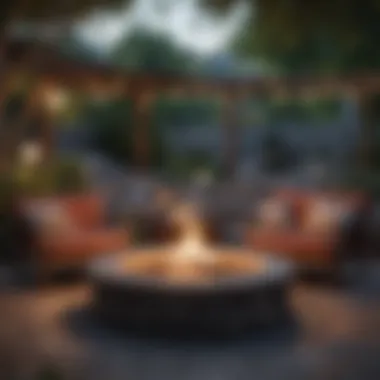

Overall, thoughtful choices in furniture can significantly elevate the overall backyard experience. By focusing on durability, modularity, and comfort, homeowners can create inviting environments that cater to various needs while reflecting personal style.
Outdoor Enhancements
Outdoor enhancements significantly elevate the overall appeal and functionality of a backyard. These elements can create inviting spaces for relaxation, entertainment, and gatherings without a pool. Whether you seek warmth from fire pits, atmospheric lighting, or the tranquil sounds of water features, these enhancements cater to varied needs and preferences.
Fire Pits and Gather Around
Fire pits serve as a central gathering point in any outdoor setting. They not only provide warmth but also foster a communal atmosphere, encouraging conversations and social interactions. Selecting the right fire pit depends on the size of your backyard and your intended use. Options range from portable models to built-in versions. When choosing materials, look for options that are durable and resistant to changes in weather, such as steel or stone.
Consider the placement of your fire pit. It should be positioned away from flammable structures and provide enough space for comfortable seating. Surrounding the fire pit with seating creates a cozy ambiance. You might also think about adding a few cushions or throws for added comfort. Remember that safety is crucial. Ensure you have necessary tools and a way to extinguish flames readily available.
Lighting Solutions for Ambiance
Lighting plays a critical role in transforming outdoor spaces. Proper lighting can highlight features, deter unwanted visitors, and provide an inviting atmosphere during evening gatherings. There are multiple options available, from string lights to solar-powered lanterns. Uneven lighting can create enchanting patterns and invite exploration.
When planning, consider layering your lighting. Ambient lighting provides general illumination, task lighting helps with specific activities, and accent lighting draws attention to certain features like plants or sculptures. Use warm colors to create a cozy environment and cooler tones for a sleek, modern look. Smart outdoor lights offer flexibility, allowing you to control brightness and color from your smartphone or with voice commands.
Incorporating Water Features
Water features add an element of peace and serenity to your backyard. They can range from small fountains to larger ponds. The sound of flowing water promotes relaxation and can mask unwelcome noises from nearby streets or neighbors. A well-placed fountain can serve as a focal point, while a pond encourages wildlife, integrating nature into your space.
When planning your water feature, consider size and maintenance. Smaller features require less upkeep, while larger ones can enhance biodiversity but may need regular cleaning and management. Include plants around the water feature to improve aesthetics and provide habitats for wildlife. Ensure that any water elements are safe for children or pets if they are part of your household.
The right outdoor enhancements can fundamentally change the way you interact with your backyard, creating spaces that are both beautiful and functional.
These enhancements are more than mere decorative additions; they are critical for creating a serene and inviting outdoor haven.
Gardening and Sustainability Practices
Understanding sustainable practices is fundamental. These methods encompass various techniques that prioritize the health of the land while maximizing the usefulness of the garden. Implementing these strategies does not have to be overwhelming. Instead, it can be an enriching experience that promotes mindfulness about what we consume and the environment.
Edible Gardens and Vegetable Patches
Creating an edible garden or a vegetable patch can serve multiple purposes. It provides fresh ingredients for the kitchen, minimizes trips to the grocery store, and encourages healthy eating habits. With the right planning, a patch can be integrated into any outdoor space, even small ones. Consider using raised beds for easy access and improved soil conditions.
Some of the benefits of establishing an edible garden include:
- Knowledge Gain: Homeowners can learn about horticulture and the growth cycle of plants.
- Health Benefits: Growing your own vegetables promotes a healthy diet.
- Cost-Effectiveness: Reduces grocery bills over time.
Communities are increasingly embracing these concepts, leading to a resurgence in home gardening. Shared gardening spaces can further benefit neighborhoods and foster community spirit.
Composting Considerations for Nutrient Management
Composting represents a straightforward sustainability method that enriches the garden's soil without relying on chemical fertilizers. By recycling organic waste like kitchen scraps and yard debris, homeowners can create nutritious compost that boosts plant growth.
When starting a compost pile, it is essential to understand:
- Carbon-to-Nitrogen Ratio: Balance brown materials (dry leaves) with green materials (kitchen waste).
- Aeration: Regularly turning the compost can speed up the decomposition process.
- Moisture: Ensure the pile is damp but not soggy.
Implementing composting leads to an enriched garden, reduces waste, and minimizes harmful inputs. This practice also reinforces the principle of closed-loop systems in gardening.
Using Mulch for Moisture Retention
Applying mulch can significantly impact the moisture levels in the garden. Mulch serves as a protective layer over soil, reducing evaporation, keeping grounds cooler in hot weather, and suppressing weed growth.
Different types of mulch can be used:
- Organic Mulch: Made from natural materials like wood chips, straw, or leaves, it enriches the soil as it breaks down.
- Inorganic Mulch: Includes materials such as gravel or plastic, which provide long-term ground cover without decomposition.
Benefits of using mulch include:
- Reduced Watering Needs: Less frequent watering saves time and resources.
- Improved Soil Health: Adds organic matter that nurtures plant life.
"Mulch acts as a shield for the soil, protecting its vitality while promoting better growth for plants."
Creating Private Spaces

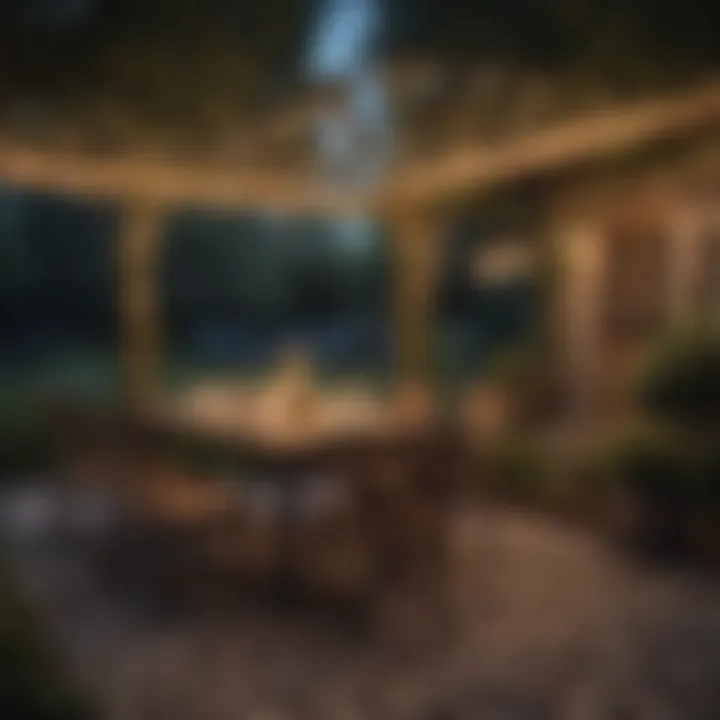
Creating private spaces in your backyard offers a sanctuary away from the daily hustle and bustle. Privacy is essential for relaxation, social gatherings, and personal reflection. A well-designed private area can become your personal retreat, enhancing the overall enjoyment of your outdoor environment.
The significance of private spaces cannot be overstated. They foster a sense of security and peace. Homeowners usually want to enjoy their yards without the fear of prying eyes. Additionally, private spaces are beneficial for gatherings, allowing friends and family to connect in a comfortable setting. This leads to a more inviting atmosphere and enhances the social experience.
Using Hedges for Natural Barriers
Utilizing hedges as natural barriers is a classic and effective method for enhancing privacy in your backyard. These living walls can blend seamlessly into the landscape while providing sufficient coverage from external views. When selecting hedges, consider the following:
- Height: Choose hedges that can reach a suitable height to shield your space.
- Density: Denser hedges provide more privacy and block noise.
- Plant Variety: Select native or adapted plants that thrive in your climate for easy maintenance.
Examples of suitable plants include Boxwood, Thuja Green Giant, and Privet. Hedges can be pruned to maintain a clean look, giving your yard an organized appearance while also expanding the greenery. In addition to privacy, these plants can offer a habitat for local wildlife, enhancing biodiversity.
"Hedges not only act as natural barriers but also add aesthetic value and connection to nature."
Building Privacy Screens
Building privacy screens is another practical approach to create secluded areas in your backyard. Screens can be made from a variety of materials, such as wood, metal, or even fabric. Here are a few points to keep in mind when planning your privacy screens:
- Material Selection: Choose durable materials that withstand weather conditions while complementing your overall design.
- Design Elements: Consider incorporating design elements such as lattice work or decorative patterns that add visual interest.
- Placement: Position screens strategically to block views from neighbors or public spaces.
A wooden privacy screen can provide an attractive and sturdy option, while metal screens can add a modern touch to your landscape. Furthermore, privacy screens can be enhanced with climbing plants, providing added greenery and a natural feel, making the spaces even more inviting.
Practical Maintenance Solutions
Maintaining a backyard efficiently is essential for ensuring that outdoor spaces remain inviting and functional without a pool. Practical maintenance solutions focus on sustainability and ease of care, which is crucial for homeowners who desire a beautiful yard without dedicating extensive time and effort to upkeep. The following sections emphasize the importance of year-round care and the selection of low-maintenance plants, helping to simplify the journey to a vibrant backyard.
Year-Round Care Tips
Year-round care is vital in preserving the look and health of any garden or backyard. Different seasons bring distinct challenges and tasks to attend to. Familiarizing oneself with these tasks can lead to a flourishing space. Here are some tips for effective year-round management:
- Spring: Focus on cleaning up debris, trimming overgrown plants, and applying mulch to garden beds. Fertilizing lawn and flower areas can give everything a boost as growth resumes.
- Summer: Focus on regular watering and trimming to control plant growth. Keep an eye out for pests, as they tend to be more prevalent during warmer months.
- Fall: Prepare for winter by cleaning leaves and debris. It's also the right time for planting perennial plants that will bloom in spring.
- Winter: Maintain pathways free from snow or ice, and protect delicate plants by wrapping them or covering them with mulch.
Maintaining a routine based on seasonal needs not only promotes healthy growth but also ensures that the backyard remains aesthetically pleasing through every stage of the year.
Choosing Low-Maintenance Plants
Selecting low-maintenance plants can significantly reduce the workload related to backyard care. These plants are often hearty, resilient, and require minimal irrigation or special attention. When choosing plants for your backyard, consider the following:
- Native Species: Native plants are adapted to local climate and soil conditions. For instance, species like California poppy and Purple coneflower require less water and care because they are well-suited to their environment.
- Drought-Resistant Plants: Consider varieties like Sedum and Lavender. These require little watering and are perfect for those in areas prone to dry spells.
- Perennials Over Annuals: Opt for perennial plants, which return year after year. They may require a bit of care initially, but they save time on replanting each season.
By selecting the right plants, one can create an attractive and manageable garden that flourishes with minimal effort.
Effective maintenance is not only beneficial for the plants but creates an inviting atmosphere for family and guests alike.
Ending and Future Trends
The conclusion wraps together the various aspects discussed in the article about enhancing a backyard without a pool. It emphasizes the importance of creativity in outdoor spaces. Homeowners are increasingly looking for ways to personalize their backyards, making them extensions of their homes. The trend is moving towards multifunctional areas that serve various purposes, from relaxation spots to vibrant entertainment zones.
The benefits of these evolving trends are significant. Firstly, they allow homeowners to maximize their space effectively. Rather than a single-feature pool, diverse elements like fire pits or outdoor kitchens contribute to a valuable addition to their properties. These improvements also increase property value, which is vital for any homeowner.
Considerations about future trends also include sustainability practices and the use of eco-friendly materials. Homeowners are aware of their environmental impact. Therefore, integrating native plants and water-efficient landscaping techniques will continue to rise. This shift shows a convergence between aesthetic appeal and environmental responsibility.
"The challenge for current and future backyard designs lies in balancing practical needs with a clear vision of aesthetics."
Ultimately, the conclusions drawn here pave the way for future exploration in backyard design. Thinking about diverse enhancements now sets the stage for continued innovation and personalization in outdoor living spaces.
Evolving Outdoor Aesthetics
The aesthetic appeal of backyards is undergoing significant transformations. No longer is the traditional idea of outdoor space strictly functional. There is a deeper focus on creating environments that reflect personal style. Homeowners are drawn to more artistic layouts, incorporating colors, textures, and forms that harmonize with nature.
Key elements of evolving aesthetics include:
- Color Palettes: Utilizing earth tones and vibrant accents can define spaces. The best palettes create calm and inviting atmospheres.
- Materials: The choice of materials is also essential. Durable stone, reclaimed wood, and metal accents contribute to a trendy, cohesive design.
- Themes: Many homeowners choose to design around specific themes such as tropical, minimalist, or rustic. This thematic planning creates visual coherence.
These aesthetics not only beautify but also add layers of meaning to the outdoor experience.
Anticipating Changes in Gardening Practices
Gardening practices are evolving to meet modern demands. Sustainability and efficiency are at the forefront. Changing gardening trends often align with the greater environmental movement. Homeowners seek to grow food, support local ecosystems, and enhance biodiversity.
Practices gaining popularity include:
- Permaculture: This philosophy promotes harmony with nature, combining crops and plants for better yield and ecological balance.
- Vertical Gardens: Space-saving vertical gardens allow for more plants in limited spaces while adding aesthetic value.
- Hydroponics: Soil-less gardening practices are increasing, especially in urban settings where soil quality may be poor.
These approaches redefine traditional gardening. They align with a future that values resource conservation, while simultaneously catering to the aesthetic appeal of backyard spaces.



